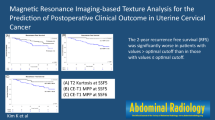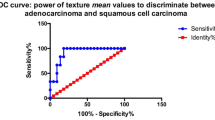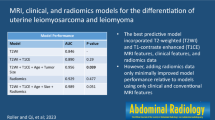Abstract
Objective
The aim of this study was to retrospectively evaluate the clinical significance of 18F-FDG PET/CT textural features for discriminating uterine sarcoma from leiomyoma.
Methods
Fifty-five patients with suspected uterine sarcoma based on ultrasound and MRI findings who underwent pretreatment 18F-FDG PET/CT were included. Fifteen patients were histopathologically proven to have uterine sarcoma, 14 patients by surgical operation and one by biopsy, and 40 patients were diagnosed with leiomyoma by surgical operation or in a follow-up for at least 2 years. A texture analysis was performed on PET/CT images from which second- and higher order textural features were extracted in addition to standardized uptake values (SUVs) and other first-order features. The accuracy of PET features for differentiating between uterine sarcoma and leiomyoma was evaluated using a receiver-operating-characteristic (ROC) analysis.
Results
The intratumor distribution of 18F-FDG was more heterogeneous in uterine sarcoma than in leiomyoma. Entropy, correlation, and uniformity calculated from normalized gray-level co-occurrence matrices and SUV standard deviation derived from histogram statistics showed greater area under the ROC curves (AUCs) than did maximum SUV for differentiating between sarcoma and leiomyoma. Entropy, as a single feature, yielded the greatest AUC of 0.974 and the optimal cut-off value of 2.85 for entropy provided 93% sensitivity, 90% specificity, and 92% accuracy. When combining conventional features with textural ones, maximum SUV (cutoff: 6.0) combined with entropy (2.85) and correlation (0.73) provided the best diagnostic performance (100% sensitivity, 94% specificity, and 95% accuracy).
Conclusions
In combination with the conventional histogram statistics and/or volumetric parameters, 18F-FDG PET/CT textural features reflecting intratumor metabolic heterogeneity are useful for differentiating between uterine sarcoma and leiomyoma.


Similar content being viewed by others
References
Adams Hillard PJ. Benign disease of the female reproductive tract. In: Berek JS, editor. Berek and Novak’s gynecology. 14th edn. Philadelphia, PA: Lippincott Williams and Wilkins; 2007. pp. 431–504.
D’Angelo E, Prat J. Uterine sarcomas: a review. Gynecol Oncol. 2010;116:131–9.
Gadducci A. Prognostic factors in uterine sarcoma. Best Pract Res Clin Obstet Gynaecol. 2011;25:783–95.
Namimoto T, Yamashita Y, Awai K, Nakaura T, Yanaga Y, Hirai T, et al. Combined use of T2-weighted and diffusion-weighted 3-T MR imaging for differentiating uterine sarcomas from benign leiomyomas. Eur Radiol. 2009;19:2756–64.
Sato K, Yuasa N, Fujita M, Fukushima Y. Clinical application of diffusion-weighted imaging for preoperative differentiation between uterine leiomyoma and leiomyosarcoma. Am J Obstet Gynecol. 2014;210:368.e1–8.
Lin G, Yang LY, Huang YT, Ng KK, Ng SH, Ueng SH, et al. Comparison of the diagnostic accuracy of contrast-enhanced MRI and diffusion-weighted MRI in the differentiation between uterine leiomyosarcoma/smooth muscle tumor with uncertain malignant potential and benign leiomyoma. J Magn Reson Imaging. 2016;43:333–42.
Gerlinger M, Rowan AJ, Horswell S, Larkin J, Endesfelder D, Gronroos E, et al. Intratumor heterogeneity and branched evolution revealed by multiregion sequencing. N Engl J Med. 2012;366:883–92.
Basu S, Kwee TC, Gatenby R, Saboury B, Torigian DA, Alavi A. Evolving role of molecular imaging with PET in detecting and characterizing heterogeneity of cancer tissue at the primary and metastatic sites, a plausible explanation for failed attempts to cure malignant disorders. Eur J Nucl Med Mol Imaging. 2011;38:987–91.
Pugachev A, Ruan S, Carlin S, Larson SM, Campa J, Ling CC, et al. Dependence of FDG uptake on tumor microenvironment. Int J Radiat Oncol Biol Phys. 2005;62:545–53.
El Naqa I, Grigsby P, Apte A, Kidd E, Donnelly E, Khullar D, et al. Exploring feature-based approaches in PET images for predicting cancer treatment outcomes. Pattern Recognit. 2009;42:1162–71.
Chicklore S, Goh V, Siddique M, Roy A, Marsden PK, Cook GJ. Quantifying tumour heterogeneity in 18F-FDG PET/CT imaging by texture analysis. Eur J Nucl Med Mol Imaging. 2013:133–40.
Xu R, Kido S, Suga K, Hirano Y, Tachibana R, Muramatsu K, et al. Texture analysis on 18F-FDG PET/CT images to differentiate malignant and benign bone and soft-tissue lesions. Ann Nucl Med. 2014;28:926–35.
Yang F, Thomas MA, Dehdashti F, Grigsby PW. Temporal analysis of intratumoral metabolic heterogeneity characterized by textural features in cervical cancer. Eur J Nucl Med Mol Imaging. 2013;40:716 – 27.
Cook GJ, O’Brien ME, Siddique M, Chicklore S, Loi HY, Sharma B, et al. Non-small cell lung cancer treated with Erlotinib: heterogeneity of 18F-FDG uptake at PET-association with treatment response and prognosis. Radiology. 2015;276:883–93.
Tixier F, Le Rest CC, Hatt M, Albarghach N, Pradier O, Metges JP, et al. Intratumor heterogeneity characterized by textural features on baseline 18F-FDG PET images predicts response to concomitant radiochemotherapy in esophageal cancer. J Nucl Med. 2011;52:369–78.
Orlhac F, Thézé B, Soussan M, Boisgard R, Buvat I. Multiscale texture analysis: From 18F-FDG PET images to histologic images. J Nucl Med. 2016;57:1823–8.
Orlhac F, Nioche C, Soussan M, Buvat I. Understanding changes in tumor textural indices in PET: a comparison between visual assessment and index values in simulated and patient data. J Nucl Med. 2017;58:387–92.
Cheng NM, Fang YH, Chang JT, Huang CG, Tsan DL, Ng SH, et al. Textural features of pretreatment 18F-FDG PET/CT images: prognostic significance in patients with advanced T-stage oropharyngeal squamous cell carcinoma. J Nucl Med. 2013;54:1703–9.
DeLong ER, DeLong DM, Clarke-Pearson DL. Comparing the areas under two or more correlated receiver operating characteristic curves: a nonparametric approach. Biometrics. 1988;44:837–45.
Kitajima K, Murakami K, Kaji Y, Sugimura K. Spectrum of FDG PET/CT findings of uterine tumors. AJR Am J Roentgenol. 2010;195:737–43.
Yoshida Y, Kurokawa T, Sawamura Y, Shinagawa A, Tsujikawa T, Okazawa H, et al. Comparison of 18F-FDG PET and MRI in assessment of uterine smooth muscle tumors. J Nucl Med. 2008;49:708–12.
Nagamatsu A, Umesaki N, Li L, Tanaka T. Use of 18F-fluorodeoxyglucose positron emission tomography for diagnosis of uterine sarcomas. Oncol Rep. 2010;23:1069–76.
Aerts HJ, Velazquez ER, Leijenaar RT, Parmar C, Grossmann P, Carvalho S, et al. Decoding tumour phenotype by noninvasive imaging using a quantitative radiomics approach. Nat Commun. 2014;5:4006.
Hatt M, Tixier F, Pierce L, Kinahan PE, Le Rest CC, Visvikis D. Characterization of PET/CT images using texture analysis: the past, the present… any future? Eur J Nucl Med Mol Imaging. 2017;44:151–65.
Acknowledgements
The authors thank Dr. Yu-Hua Dean Fang, the original developer of the Chang-Gung Image Texture Analysis toolbox, and the staff of the Department of Radiology and Biological Imaging Research Center, University of Fukui, for their clinical and technical support.
Author information
Authors and Affiliations
Corresponding author
Ethics declarations
Consent to participate
Formal consent was not required for this type of retrospective study.
Conflict of interest
The authors have no conflicts of interest to declare.
Funding
This study was partly funded by Grants-in-Aid for scientific research from the Japan Society for the Promotion of Science (15H04981, 16K10345, and 16K20181) and Takeda Science Foundation.
Electronic supplementary material
Below is the link to the electronic supplementary material.
Rights and permissions
About this article
Cite this article
Tsujikawa, T., Yamamoto, M., Shono, K. et al. Assessment of intratumor heterogeneity in mesenchymal uterine tumor by an 18F-FDG PET/CT texture analysis. Ann Nucl Med 31, 752–757 (2017). https://doi.org/10.1007/s12149-017-1208-x
Received:
Accepted:
Published:
Issue Date:
DOI: https://doi.org/10.1007/s12149-017-1208-x




